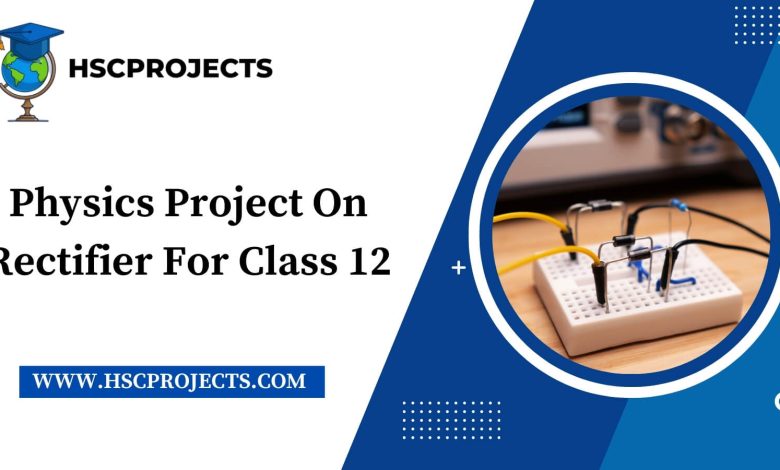
Physics Project On Rectifier For Class 12
Acknowledgment
Completing this project on rectifiers has been a rewarding and insightful journey, and I extend my heartfelt appreciation to those who have contributed to its successful realization.
Firstly, I would like to express my gratitude to [Teacher’s Name], whose guidance and expertise have been instrumental throughout this project. Their encouragement, valuable suggestions, and unwavering support have played a pivotal role in shaping the direction of this endeavor.
I am also thankful to my classmates and fellow enthusiasts who have shared their knowledge and insights during discussions and collaborative sessions. The exchange of ideas has added depth to the project and enhanced my overall understanding of rectifiers.
Special acknowledgment is due to [Name], who generously shared resources and references, enriching the theoretical foundation of this project. The insights gained from these references have greatly contributed to the depth and accuracy of our exploration into rectifiers.
Furthermore, I extend my appreciation to [Name] for their assistance in the practical aspects of the project. Their hands-on expertise and willingness to share experiences have significantly enriched the experimental phase of this endeavor.
Lastly, I want to express gratitude to my family for their unwavering support and understanding during the course of this project. Their encouragement and patience have been a constant source of motivation.
Each contribution, whether large or small, has played a vital role in the successful completion of this project. This collaborative effort has not only deepened my understanding of rectifiers but has also underscored the importance of teamwork and shared knowledge in the pursuit of scientific exploration. Once again, thank you to everyone who has been part of this endeavor.
Sincerely,
[Your Full Name][Class/Grade]
[School Name]
Introduction
Rectifiers play a fundamental role in the field of electronics by facilitating the conversion of alternating current (AC) into direct current (DC). This project delves into the intricate workings of rectifiers, focusing on two main types: the Half-Wave Rectifier and the Full-Wave Rectifier, specifically the Bridge Rectifier configuration. The ability to transform AC to DC is essential for numerous electronic applications, ranging from powering everyday devices to facilitating battery charging and industrial processes like electroplating.
In this project, we aim to unravel the principles underlying rectification and, in turn, demonstrate the practical application of rectifier circuits. By understanding the nuances of both half-wave and full-wave rectifiers, we seek to explore their advantages, disadvantages, and the significance of their implementation in various technological domains. This project not only provides a hands-on experience in constructing and observing rectifier circuits but also offers insights into the broader realm of electrical engineering and its real-world applications. As we embark on this exploration, we aim to gain a comprehensive understanding of rectifiers and their pivotal role in shaping the landscape of modern electronics.
The journey through rectifiers holds a crucial place in the realm of electrical engineering, where the transformation of alternating current into a unidirectional flow is a prerequisite for numerous electronic devices and systems. Rectifiers act as the gatekeepers, regulating the flow of electrical currents in a controlled manner, enabling the steady supply of power for a myriad of applications.
This project takes a focused approach to examine two key types of rectifiers — the Half-Wave Rectifier and the Full-Wave Rectifier with the Bridge Rectifier configuration. The Half-Wave Rectifier, with its simple design using a single diode, allows us to explore the foundational principles of rectification by allowing only one half of the AC waveform. On the other hand, the Full-Wave Rectifier, employing a more complex Bridge configuration with four diodes, extends our exploration to harness both halves of the AC waveform, promising a more efficient conversion of AC to DC.
As we embark on constructing and analyzing these rectifier circuits, we will delve into the practical aspects of their operation. The project aims not only to showcase the theoretical underpinnings of rectifiers but also to provide tangible, hands-on experiences that deepen our comprehension of the subject matter. Through systematic observations, comparisons, and measurements of output waveforms, we intend to unravel the nuances of each rectifier type.
Beyond the confines of our experiment, this project invites reflection on the broader implications of rectifiers in real-world applications. From powering our homes with stable DC voltages to enabling the seamless charging of electronic devices, rectifiers form the backbone of modern electrical systems. By grasping the intricacies of rectification, we not only enhance our knowledge of electrical engineering principles but also gain insights into the indispensable role that rectifiers play in advancing technology.
Understanding Rectifier Types
- Half-Wave Rectifier: Utilizing a single diode, the half-wave rectifier allows only one half of the AC waveform to pass through. This simple yet effective design forms the foundation of AC to DC conversion.
- Full-Wave Rectifier: Enter the bridge rectifier, a more sophisticated setup employing four diodes in a bridge configuration. This design permits both halves of the AC waveform to be utilized, enhancing efficiency in the conversion process.

Procedure
- Half-Wave Rectifier Demonstration: a. Connect a diode to the transformer’s secondary winding. b. Introduce a load resistor in series. c. Connect the setup to an AC power supply. d. Employ a voltmeter to measure the output.
- Full-Wave Rectifier Demonstration: a. Assemble four diodes in a bridge configuration. b. Integrate a load resistor into the circuit. c. Connect the system to an AC power supply. d. Utilize a voltmeter to measure the output.
Observations
Half-Wave Rectifier
- Observe the shape of the waveform.
- Measure the DC voltage across the load resistor.
Full-Wave Rectifier
- Observe the shape of the waveform.
- Measure the DC voltage across the load resistor.

Comparative Analysis
- Examine and compare the waveforms obtained from both the half-wave and full-wave rectifiers.
- Measure and analyze the DC voltages across the load resistors in each case.
Advantages and Disadvantages
- Discuss the advantages and disadvantages of each rectifier type based on the observed results.
- Consider factors such as simplicity, efficiency, and cost-effectiveness.
Efficiency and Application Suitability
- Evaluate the efficiency of each rectifier in converting AC to DC power.
- Discuss the suitability of each rectifier type for specific applications, considering the observed waveform characteristics.
Conclusion
In the culmination of this project on rectifiers, we find ourselves at the intersection of theoretical exploration and practical application, having traversed the intricacies of converting alternating current (AC) to direct current (DC). Through the examination of both the Half-Wave Rectifier and the Full-Wave Rectifier with the Bridge Rectifier configuration, we have gained valuable insights into the fundamental principles that govern electrical systems.
Our journey began with a theoretical understanding of rectifiers, recognizing their pivotal role in electronics. The hands-on construction and analysis of the Half-Wave Rectifier allowed us to witness the selective passage of one half of the AC waveform, laying the foundation for comprehending the essentials of rectification. Transitioning to the Full-Wave Rectifier, specifically the Bridge Rectifier, expanded our scope, enabling us to harness the complete AC waveform for a more efficient conversion to DC.
Through meticulous observation, comparison of waveforms, and measurement of DC voltages, we have not only validated theoretical concepts but also grasped the practical implications of choosing one rectifier configuration over another. The Half-Wave Rectifier, though simple, revealed its limitations in terms of efficiency, while the Full-Wave Rectifier exhibited a more stable and continuous DC output.
In a broader context, this project has underscored the ubiquity of rectifiers in our daily lives. From powering electronic devices to providing a reliable source of energy, rectifiers form the backbone of our modern electrical infrastructure. The project has, therefore, not only been an academic exercise but a journey into the heart of technology, where theoretical knowledge transforms into tangible applications.
In conclusion, this project on rectifiers has been a comprehensive exploration, encompassing theoretical foundations, practical experiments, and reflections on real-world applications. As we conclude this endeavor, we carry forward a deeper appreciation for the intricate workings of rectifiers and their indispensable role in shaping the landscape of electrical engineering. This project stands as a testament to the fusion of knowledge, experimentation, and the enduring pursuit of understanding the science that powers our world.
Importance in Various Applications
- Emphasize the significance of understanding rectifiers in the broader context of electronics.
- Discuss the impact of rectifiers in applications like power supplies, battery charging, and electroplating.
Bibliography
- Horowitz, Paul, and Winfield Hill. The Art of Electronics. Cambridge University Press, 2015.
- Sedra, Adel S., and Smith, Kenneth C. Microelectronic Circuits. Oxford University Press, 2014.
- Boylestad, Robert L., and Nashelsky, Louis. Electronic Devices and Circuit Theory. Pearson, 2018.
- Streetman, Ben G., and Banerjee, Sanjay. Solid State Electronic Devices. Pearson, 2015.
- Website: All About Circuits
- Reference Article: Rectifier Circuits on Electronics Tutorials.
- Reference Book: Milliman, Jacob, and Halkias, Christos C. Integrated Electronics: Analog and Digital Circuits and Systems. Tata McGraw-Hill, 2008.
Certificate of Completion
[Student’s Name][Class/Grade Level]This is to certify that I, [Student’s Name], a [Class/Grade Level] student, have successfully completed the “physics project on rectifier for class 12.” The project explores the fundamental principles and key aspects of the chosen topic, providing a comprehensive understanding of its significance and implications.
In this project, I delved into in-depth research and analysis, investigating various facets and relevant theories related to the chosen topic. I demonstrated dedication, diligence, and a high level of sincerity throughout the project’s completion.
Key Achievements:
Thoroughly researched and analyzed Project on physics project on rectifier for class 12 .
Examined the historical background and evolution of the subject matter.
Explored the contributions of notable figures in the field.
Investigated the key theories and principles associated with the topic.
Discussed practical applications and real-world implications.
Considered critical viewpoints and alternative theories, fostering a well-rounded understanding.
This project has significantly enhanced my knowledge and critical thinking skills in the chosen field of study. It reflects my commitment to academic excellence and the pursuit of knowledge.
Date: [Date of Completion]Signature: [Your Signature] [School/Institution Name][Teacher’s/Examiner’s Name and Signature]
In order to download the PDF, You must follow on Youtube. Once done, Click on Submit
Follow On YoutubeSubscribed? Click on Confirm
Download Physics Project On Rectifier For Class 12 PDF






